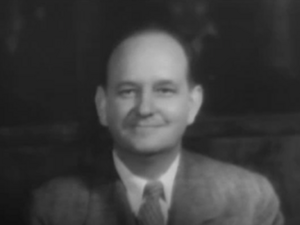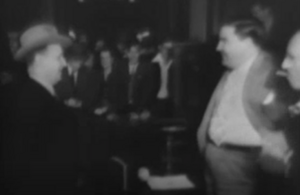Ellis Arnall facts for kids
Quick facts for kids
Ellis Arnall
|
|
|---|---|
 |
|
| 69th Governor of Georgia | |
| In office January 12, 1943 – January 14, 1947 |
|
| Preceded by | Eugene Talmadge |
| Succeeded by | Eugene Talmadge (elect) |
| Attorney General of Georgia | |
| In office 1939–1943 |
|
| Governor | Eurith D. Rivers Eugene Talmadge |
| Preceded by | M. J. Yeomans |
| Succeeded by | T. Grady Head |
| Personal details | |
| Born |
Ellis Gibbs Arnall
March 20, 1907 Newnan, Georgia, U.S. |
| Died | December 13, 1992 (aged 85) Atlanta, Georgia, U.S. |
| Resting place | Oak Hill Cemetery Newnan, Georgia, U.S. |
| Political party | Democratic |
| Other political affiliations |
Independent (1966) |
| Spouses | Mildred Delany Slemons Arnall Ruby Hamilton Arnall |
| Alma mater | Mercer University University of the South University of Georgia School of Law |
| Profession | Attorney |
Ellis Gibbs Arnall (March 20, 1907 – December 13, 1992) was an American politician. He served as the 69th Governor of Georgia from 1943 to 1947. As a Democrat, he worked to remove the poll tax and lower Georgia's voting age to 18. After being governor, he became a very successful lawyer and businessman.
Contents
Learning and Early Career Steps
Ellis Arnall was born in Newnan, Georgia. He went to Mercer University in Macon, Georgia. Then, he studied at the University of the South and the University of Georgia School of Law. He became a lawyer in 1931. While at Mercer University, he joined a group called Kappa Alpha Order.
In 1932, people in Coweta County chose Arnall to be part of the Georgia House of Representatives. He was later elected Speaker Pro Tempore, which is the second most important job in the Georgia House. When he was 31, Governor Eurith D. Rivers picked him to be the state's attorney general.
In 1935, he married Mildred Slemons. They were very happy together until she passed away in 1980. Mildred supported her husband throughout his political career, even though she didn't enjoy politics herself.
Becoming Governor of Georgia
Before Arnall became governor, the state's colleges had lost their special approval because of actions taken by Governor Eugene Talmadge. In 1942, Arnall ran against Talmadge and won the election. He became the youngest governor in the United States at that time.
As governor, Arnall made many important changes. He ended the poll tax, which was a fee people had to pay to vote. He also helped create a new state constitution in 1945. Arnall also paid off Georgia's state debt.
One of his biggest achievements was lowering the voting age. During World War II, many young men were fighting for their country. Arnall believed that if they were old enough to fight, they should be old enough to vote. He successfully lowered the voting age in Georgia to eighteen. This happened more than 20 years before the 26th Amendment made it a national rule. Georgia was the first state to let 18-year-olds vote.
Arnall also changed how the prison system worked. He created a board to manage state prisons and a board to handle requests for pardons. He also made sure the University of Georgia was free from political interference. Arnall worked to stop governors from having too much power, which some people said had happened before. His reforms made him well-known across the country. He also believed that African Americans should be able to vote in the state's primary elections.
Trying for Re-election
Arnall wanted to run for governor again, but the state legislature would not let him. He supported Henry A. Wallace in 1944, who was replaced as Vice President by Harry S. Truman.
Arnall followed the U.S. Supreme Court's decision that said only white people could not vote in the Democratic primary election. This meant African Americans could now vote in these important elections. This decision made Eugene Talmadge and his supporters very angry. They called Arnall a "race-traitor" because of it.
In 1946, Eugene Talmadge was elected governor again. However, he passed away a month before he was supposed to start his term in January 1947. The state legislature then chose Talmadge's son, Herman Talmadge, to be governor. Arnall refused to leave his office during this confusing time. Herman Talmadge ended up locking Arnall out of the governor's office in the state capitol building.
Life After Being Governor
After leaving office, Arnall became a lawyer and businessman in Atlanta. He started a law firm called Arnall Golden & Gregory, which is still a major law firm today. For a short time, he worked for President Harry S. Truman as the Director of the Office of Price Stabilization. Truman offered him another important job as Solicitor General, but Arnall chose to go back to his private law practice. His business career made him a very wealthy man.
The 1966 Election
Arnall's last campaign for public office was for governor in 1966. He ran against Lester Maddox and Jimmy Carter. Maddox was known for his strong opposition to desegregation. Arnall mostly focused on the Republican candidate, Howard Callaway.
Arnall won the most votes in the primary election, but not enough to win outright. This was because Jimmy Carter also received many votes. Arnall did not campaign much in the runoff election, and Lester Maddox surprisingly won. Carter supported Maddox in the main election against Callaway.
Maddox defeated Arnall in the runoff election. The civil rights leader Martin Luther King Jr. said that the election showed Georgia was "a sick state." The mayor of Atlanta, Ivan Allen, Jr., who used to work for Arnall, blamed Arnall's loss on "ignorance, prejudice, and trickery."
Arnall's supporters tried a "write-in" campaign for the general election. This meant people could write Arnall's name on the ballot even though he wasn't officially running. This effort affected Callaway more than Maddox. In the general election, Callaway had slightly more votes than Maddox. However, Arnall received over 69,000 write-in votes, which was more than the difference between Callaway and Maddox. Arnall even won one county, Liberty County. Because of the election rules at the time, the state legislature had to choose the governor from the top two candidates. Even after court challenges, the Democratic legislature voted for Maddox, who became governor in 1967.
After the 1966 campaign, Ellis Arnall never ran for public office again. He was also an active member of Civitan International, a community service organization.
He wrote a book in 1946 called The Shore Dimly Seen, which was about politics and challenges in the South.
Death and His Impact
A book about Ellis Arnall's life, called The Politics of Change in Georgia: A Political Biography of Ellis Arnall, was published in 1991 by Harold Paulk Henderson.
Ellis Arnall passed away in 1992 at his large home. He was worth many millions of dollars when he died. In 1997, a statue was placed on the grounds of the Georgia State Capitol to honor him.
He is buried at the Oak Hill Cemetery in his hometown of Newnan. Arnall Middle School in Newnan is named after him.


